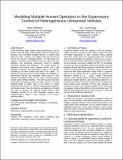| dc.contributor.author | Cummings, M. L. | |
| dc.contributor.author | Mekdeci, Brian Anthony | |
| dc.date.accessioned | 2013-10-25T16:57:09Z | |
| dc.date.available | 2013-10-25T16:57:09Z | |
| dc.date.issued | 2009-09 | |
| dc.identifier.isbn | 9781605587479 | |
| dc.identifier.isbn | 1605587478 | |
| dc.identifier.uri | http://hdl.handle.net/1721.1/81781 | |
| dc.description.abstract | In the near future, large, complex, time-critical missions, such as disaster relief, will likely require multiple unmanned vehicle (UV) operators, each controlling multiple vehicles, to combine their efforts as a team. However, is the effort of the team equal to the sum of the operator's individual efforts? To help answer this question, a discrete event simulation model of a team of human operators, each performing supervisory control of multiple unmanned vehicles, was developed. The model consists of exogenous and internal inputs, operator servers, and a task allocation mechanism that disseminates events to the operators according to the team structure and state of the system. To generate the data necessary for model building and validation, an experimental test-bed was developed where teams of three operators controlled multiple UVs by using a simulated ground control station software interface. The team structure and interarrival time of exogenous events were both varied in a 2×2 full factorial design to gather data on the impact on system performance that occurs as a result of changing both exogenous and internal inputs. From the data that was gathered, the model was able to replicate the empirical results within a 95% confidence interval for all four treatments, however more empirical data is needed to build confidence in the model's predictive ability. | en_US |
| dc.description.sponsorship | United States. Office of Naval Research | en_US |
| dc.description.sponsorship | United States. Air Force Office of Scientific Research | en_US |
| dc.language.iso | en_US | |
| dc.publisher | Association for Computing Machinery | en_US |
| dc.relation.isversionof | http://dx.doi.org/10.1145/1865909.1865911 | en_US |
| dc.rights | Creative Commons Attribution-Noncommercial-Share Alike 3.0 | en_US |
| dc.rights.uri | http://creativecommons.org/licenses/by-nc-sa/3.0/ | en_US |
| dc.source | MIT web domain | en_US |
| dc.title | Modeling multiple human operators in the supervisory control of heterogeneous unmanned vehicles | en_US |
| dc.type | Article | en_US |
| dc.identifier.citation | Mekdeci, Brian, and M. L. Cummings. “Modeling multiple human operators in the supervisory control of heterogeneous unmanned vehicles.” In Proceedings of the 9th Workshop on Performance Metrics for Intelligent Systems - PerMIS 09, 1. Association for Computing Machinery, 2009. | en_US |
| dc.contributor.department | Massachusetts Institute of Technology. Department of Aeronautics and Astronautics | en_US |
| dc.contributor.mitauthor | Mekdeci, Brian Anthony | en_US |
| dc.contributor.mitauthor | Cummings, M. L. | en_US |
| dc.relation.journal | Proceedings of the 9th Workshop on Performance Metrics for Intelligent Systems, PerMIS '09 | en_US |
| dc.eprint.version | Author's final manuscript | en_US |
| dc.type.uri | http://purl.org/eprint/type/ConferencePaper | en_US |
| eprint.status | http://purl.org/eprint/status/NonPeerReviewed | en_US |
| dspace.orderedauthors | Mekdeci, Brian; Cummings, M. L. | en_US |
| mit.license | OPEN_ACCESS_POLICY | en_US |
| mit.metadata.status | Complete | |
